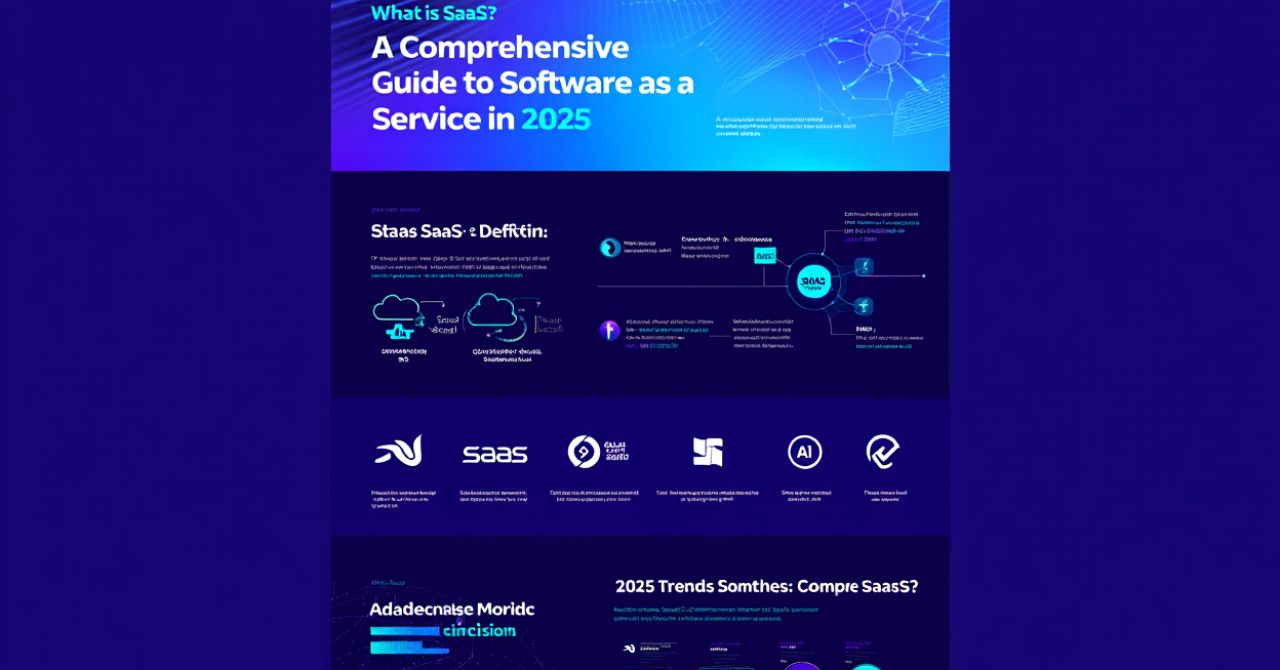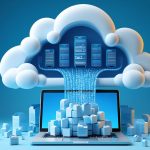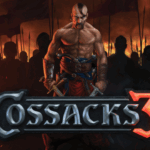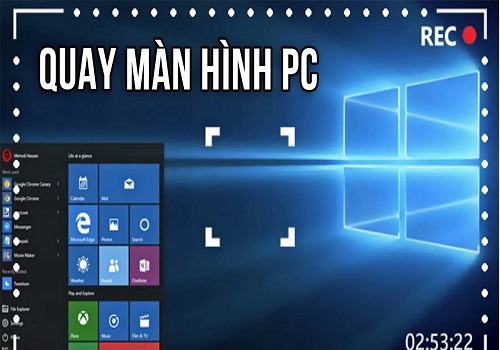Software as a Service, commonly known as SaaS, is a cloud-based delivery model where software applications are accessed online rather than installed on a local device. In simple terms, SaaS lets users use software over the internet securely and conveniently without worrying about installations or updates. This article guides you through the fundamentals of SaaS in 2025, exploring what it is, how it works, its benefits, and future trends shaping its evolution. A suggested infographic or visual timeline could illustrate SaaS’s growth from early cloud computing concepts to today’s advanced, industry-specific solutions, making the information easy to grasp at a glance.
What is SaaS?
At its core, SaaS stands for Software as a Service, a model where software is centrally hosted and provided to users via the internet. Instead of purchasing and installing applications on individual machines, SaaS allows users to access software through web browsers—think Gmail, Dropbox, or Netflix. This means users benefit from instant updates, scalability, and reduced maintenance burdens. While SaaS is a subset of cloud computing, it specifically focuses on delivering ready-to-use applications rather than the infrastructure or development platforms cloud services also offer.
To clarify, here’s a simple table contrasting the three primary cloud service models:
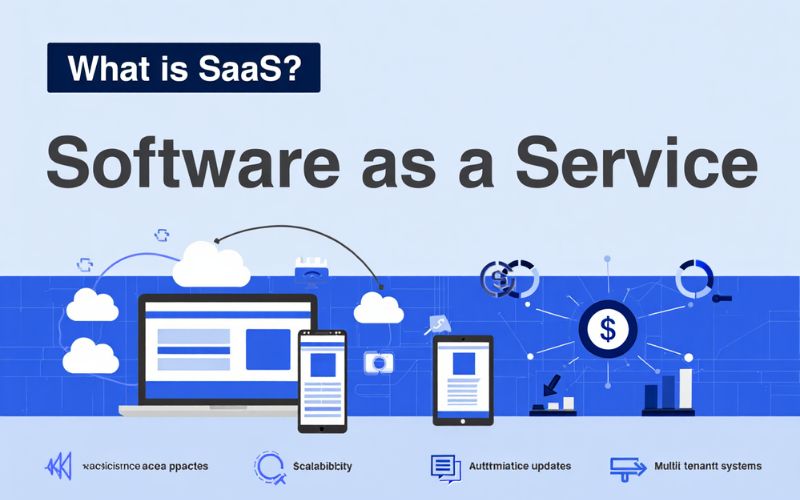
Cloud Service Models Comparison
Service Type | Description | Example
SaaS | Complete software delivery over the internet | Google Workspace
PaaS (Platform as a Service) | Cloud-based platforms for building and managing applications | Heroku, Microsoft Azure App Services
IaaS (Infrastructure as a Service) | Virtual hardware resources delivered online | Amazon AWS EC2, Google Cloud Compute Engine
How Does SaaS Work?
SaaS operates using an internet-based delivery method that enables users to run applications entirely from a web browser without local installation.
Key steps in SaaS operation include:
• Users subscribe to the software, often paying monthly or annually, replacing traditional perpetual licenses.
• The SaaS vendor hosts the software on cloud servers, handling all maintenance, updates, and infrastructure management.
• Automatic updates are seamlessly pushed by the vendor, ensuring users always have access to the latest features and security patches.
• Data is stored remotely on the vendor’s servers but users retain responsibility for data input, governance, and compliance.
• Customers access their applications anytime from any device with an internet connection, fostering flexibility and mobility.
This architecture minimizes IT overhead while empowering end-users with consistent, up-to-date tools. A flow diagram here could visually represent the process from user access to backend cloud server maintenance.
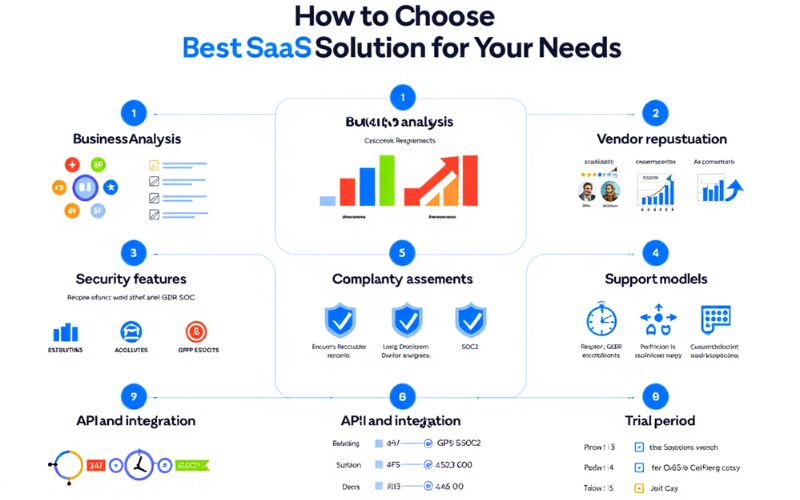
Key Characteristics of SaaS
SaaS offerings share distinct qualities that define their value and user experience, including:
• Access from any device with internet: Enables usage across desktops, tablets, or smartphones.
• Subscription-based pricing: Typically pay-as-you-go, reducing upfront costs.
• Automatic updates: Removes the need for manual software patches.
• Multi-tenancy: One software instance serves multiple users securely, optimizing resources.
• Scalability: Easily adjust user counts or resources to match demand.
• Integration capabilities: Connects to other apps and APIs for streamlined workflows.
• Minimal local IT involvement: Vendor handles hosting and maintenance.
• Robust security compliance: Vendors often provide industry-standard certifications (e.g., SOC2, GDPR).
• Customizable user experience: Allows configurable settings and personalized interfaces.
Each characteristic supports greater business agility, reduces operational friction, and enhances user satisfaction, underscoring why SaaS remains popular in modern IT strategies.
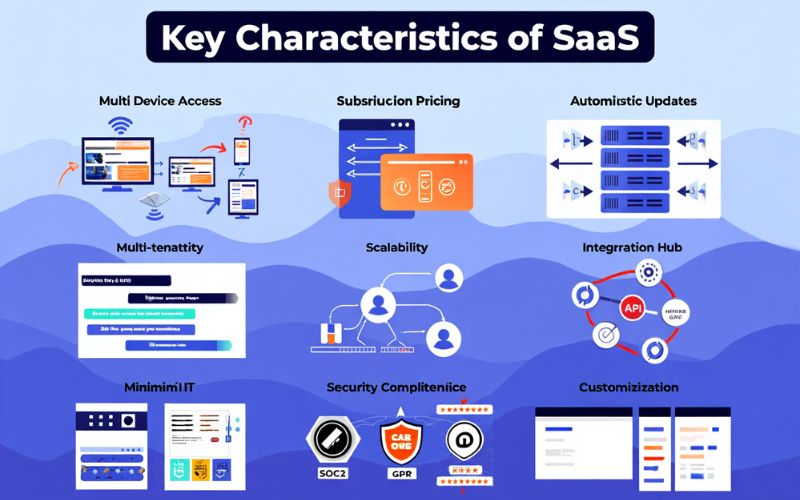
SaaS vs. Traditional Software: What’s the Difference?
The choice between SaaS and traditional on-premises software depends on many factors. Here’s a comparison table highlighting their main distinctions:
Feature | SaaS | Traditional Software
Deployment | Hosted online, accessible via browser | Installed locally on each device
Cost Model | Subscription, operational expenses | One-time license, capital expense
Maintenance | Vendor handles all updates and support | User manages updates and troubleshooting
Accessibility | Anywhere with internet connection | Limited to installed devices
Scaling | Easily scalable, flexible subscriptions | Hardware/software upgrades required
From this comparison, SaaS is ideal for businesses seeking agility, remote access, and lower upfront investments. Conversely, traditional software may suit organizations needing full control or offline operation. Understanding these differences helps in selecting the right model based on specific organizational needs.
Popular Examples of SaaS Solutions
The SaaS market offers diverse solutions tailored for various business and personal needs. Here are notable examples, organized by category:
Business: Salesforce (CRM), SAP Cloud ERP
Productivity: Microsoft 365, Google Workspace
Collaboration: Zoom, Slack
E-commerce: Shopify, BigCommerce
Education: Canvas LMS, Coursera
Finance: QuickBooks Online, Xero
Each platform helps organizations streamline particular functions, from customer relationship management to online learning. Visual grid layouts or brand icons can enhance quick recognition and association for readers.
30+ Top Benefits of SaaS for Businesses & Individuals
SaaS delivers a wide array of advantages that empower both enterprises and users. Below are over 30 key benefits grouped by category:
Cost Efficiency:
1. Eliminates hardware needs – no expensive servers required.
2. Lowers upfront costs – pay subscription fees instead of big licenses.
3. Predictable expenses – easier budgeting with fixed recurring payments.
4. Reduces IT workforce demand – less on-premises management.
Productivity & Accessibility:
5. Access from anywhere – perfect for remote work.
6. Seamless collaboration – real-time edits and communication.
7. Rapid deployment – instant access post-subscription.
8. Auto-updates – always use latest software without downtime.
9. Multi-device compatibility – use on PCs, tablets, or smartphones.
Scalability & Flexibility:
10. Easily scale up/down – accommodate growth without hardware revamp.
11. Flexible user licensing – add/remove users based on needs.
12. Customizable features – tailored experiences with configurable options.
Security & Compliance:
13. Regular security patches – vendor monitors threats.
14. Data encryption – protects information in transit and at rest.
15. Compliance certifications – ensures regulatory adherence.
16. Disaster recovery options – backups managed by providers.
Support & Maintenance:
17. Vendor-managed infrastructure – reduces downtime.
18. Professional customer service – 24/7 help desks.
19. Continuous improvements – new features introduced regularly.
20. Integration capabilities – connects with existing workflows and tools.
Environmental Impact:
21. Reduced energy consumption – shared resources lower carbon footprint.
22. Cloud efficiency – better server utilization than individual data centers.
Additional benefits include improved mobility, faster innovation cycles, global reach, and enhanced user experiences. According to Gartner, organizations adopting SaaS report up to 30% faster deployment times and 25% reduction in IT operational costs, underscoring its transformative impact.
Real-World Use Cases of SaaS in 2025
SaaS has deeply integrated into key sectors by 2025, solving distinct challenges and driving efficiency:
ERP Systems: Manufacturing companies use cloud ERP SaaS to synchronize supply chains and automate accounting.
CRM Platforms: Sales teams leverage Salesforce to track leads and improve customer relationships globally.
eCommerce: Retailers deploy Shopify to launch online stores quickly and integrate payment gateways.
Education Tech: Schools utilize Canvas to manage courses and student engagement remotely.
Healthcare: Medical clinics adopt SaaS for patient records and telemedicine scheduling.
Remote Work: Businesses rely on Slack and Zoom for daily communication and project management.
Industry-specific Software: Legal firms use SaaS for case management and compliance tracking.
These scenarios demonstrate SaaS’s flexibility to meet diverse operational demands efficiently and cost-effectively.
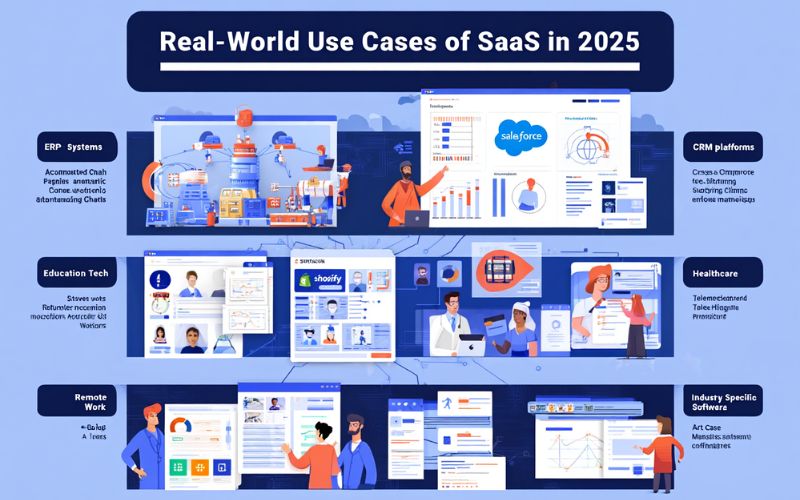
Challenges & Considerations When Using SaaS
Despite its advantages, SaaS comes with challenges that users must carefully consider:
Data Security & Privacy: Entrusting sensitive data to third parties requires due diligence on vendor security practices and compliance with regulations such as GDPR.
Internet Dependence: Reliable internet connectivity is crucial; outages can disrupt access to critical applications.
Limited Customization: SaaS solutions may offer less flexibility compared to custom-built software, potentially requiring workarounds.
Integration Issues: Connecting SaaS with legacy systems can be complex, sometimes requiring middleware.
Vendor Lock-in: Migrating data and workflows away from a SaaS provider can be difficult and costly.
Compliance Concerns: Businesses in regulated industries must ensure their SaaS vendors meet relevant standards and certifications.
Mitigation strategies include thorough vendor evaluations, contract clarity on data ownership, robust backup plans, and hybrid infrastructure where appropriate. Recent high-profile data breaches have emphasized the importance of vigilant security assessments when adopting SaaS.
How to Choose the Best SaaS Solution for Your Needs
Selecting the right SaaS platform requires a careful, stepwise approach:
• Assess business needs: Define core requirements and workflows.
• Evaluate scalability: Verify if solution adapts to growth.
• Investigate vendor reputation: Check history, reviews, and financial stability.
• Confirm security features: Look for encryption, backups, and certifications (GDPR, SOC2).
• Assess compliance: Ensure industry regulations are met.
• Review support models: Availability, response times, and technical resources.
• Consider API and data export options: Facilitate integration and exit strategies.
• Calculate total cost of ownership: Factor subscription fees, add-ons, and implementation.
• Use trial periods cautiously: Pilot testing uncovers hidden issues.
A decision matrix comparing these factors side-by-side provides clarity. Crucial “red flags” include vague contract terms, poor support responsiveness, and lack of transparent data policies. Asking vendors pointed questions about uptime guarantees, data protection, and customization can prevent costly mistakes.
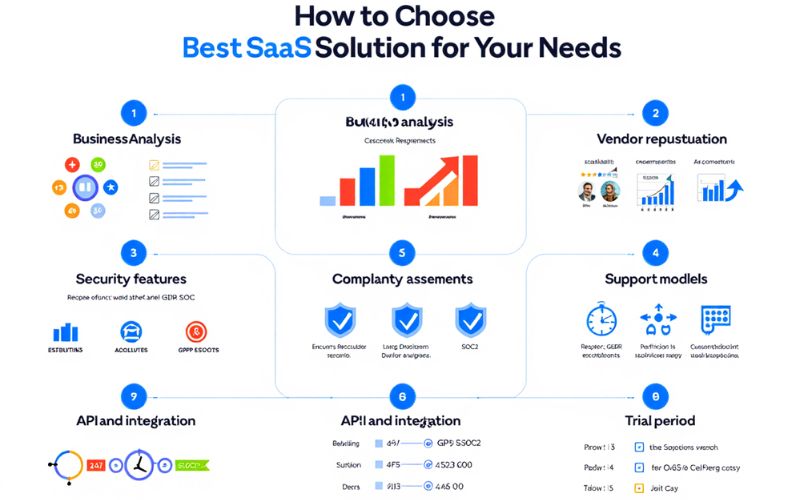
SaaS Trends & What’s Next in 2025
The SaaS landscape continues to evolve rapidly with several prominent trends shaping its future:
• AI/ML-powered SaaS: Enhanced automation and predictive analytics improve decision-making.
• Vertical/Industry-specific SaaS: Tailored solutions for sectors like healthcare, finance, and legal.
• No-code/low-code tools: Empower non-developers to build custom workflows.
• Enhanced cybersecurity: Zero-trust models integrated within SaaS platforms.
• Containerization and microservices: Increase portability and resilience.
• Hybrid/multi-cloud deployments: Flexibility to use multiple cloud providers.
• Sustainability focus: More energy-efficient data centers and greener software practices.
• Edge SaaS: Bringing cloud applications closer to users for lower latency and improved performance.
Market analysts like Gartner predict continued double-digit growth in SaaS adoption, with innovation driven by AI and real-time data capabilities. These trends promise even greater flexibility, security, and efficiency for users worldwide.
Supplementary FAQs About SaaS (Boolean, Definitional, Comparative)
Can SaaS run offline? Most SaaS applications require an internet connection; however, some offer limited offline features with data syncing once reconnected.
What is multi-tenancy? Multi-tenancy means a single software instance serves multiple clients (tenants) while keeping their data isolated and secure.
What are the main categories of SaaS? Common categories include CRM, ERP, productivity suites, collaboration tools, e-commerce platforms, and vertical-specific software.
How is SaaS different from PaaS? SaaS delivers complete applications ready to use, whereas PaaS provides platforms and tools for building custom applications.
Is data ownership an issue with SaaS? Users typically retain ownership but must review contracts carefully to understand rights and data handling policies.
Can SaaS be customized? Many SaaS products offer configurable settings, though deep customization may be limited compared to traditional software.
Are SaaS subscriptions cost-effective long-term? Generally yes, thanks to reduced hardware costs and maintenance, but assessing total lifetime cost is essential.
What happens if the vendor shuts down? Data export and migration plans should be in place to avoid disruption.
Is SaaS secure? Leading providers invest heavily in security, but ultimate responsibility includes user practices and vigilance.
How rapidly do SaaS products update? Most update automatically multiple times a year, ensuring users receive improvements and fixes promptly.
More than:
- What Is Timeboxing in Productivity Software? A Complete Guide
- What is BIOS? Everything You Need to Know
Conclusion
Understanding what SaaS is in 2025 is more important than ever, as it continues to reshape how individuals and businesses access, manage, and scale software. With unmatched flexibility, lower costs, and continuous innovation, SaaS simplifies IT for everyone—from startups to global enterprises. However, success with SaaS starts with informed decisions about security, vendor reliability, and long-term scalability. By mastering the core of what SaaS is and exploring its future trends, users can fully harness its potential in today’s cloud-first world.
Looking to explore more insights like this? Visit the Software section on Soft Buzz.net to discover expert guides, comparisons, and the latest updates in cloud-based technologies and SaaS platforms.

